Crossing the Simpson Desert by Motorcycle
Part 3 – Dalhousie to Poeppel Corner
With Mark Battersby
It was a restless night heading into Day 4 – a combination of excitement, the sound of light rain, and the realisation of what that would mean heading into the clay pans.
By 6 am I decide I can’t stay in my tent any longer and need to explore the darkness. As I venture out I begin to accept it’s not going to be an easy day, everything is wet. Norri and Mick join me at first light and they share in my concerns about the weather.
Norri invents his own weather grading system which commences at ‘Slightly Troubling’ transitioning through some colourful language and culminating with ‘Alternative Plans may be required.’

We gaze across the campsite and observe no one has yet headed into the desert. Even the campsite roads are now muddy and slippery underfoot. At one point a motorised quad approaches us from the ranger’s station and we instantly fear it’s news that the desert is closed. Thankfully that news never arrives, and we decide it’s now or never.
The rain isn’t heavy, but concerningly it’s been constant for ten hours with nothing but grey skies as far as we can see. Three 4WDs leave in convoy ahead of us and we are mindful that we need to hit the clay pans early as possible, as traffic will quickly break through the crust making them impassable, especially on the bike. We later learn the bikes we met on the Oodnadatta Track were stuck in this section for hours.
My excitement level outweighs my anxiety, no doubt because I’m unaware of the challenges ahead of me. Visibility is poor due to rain as we head out onto the barren plains and I am thankful for the sandy tracks which provide excellent traction. I never thought I’d be relieved to ride on sand, now I fear clay.
I lose all sense of time as I concentrate following Norri in the Ford Ranger. Suddenly I feel the tyres sliding as I struggle to maintain a smooth and even throttle. The Ranger starts to break traction and slide ahead of me. The clay pans only offer a thin crust before you sink into the bog which could see us stuck for hours. The track deviates to the right through light vegetation in an attempt to avoid the clutches of the clay.
The next hour was a blur as we continued at walking pace navigating the clay, through rarely used clay tracks. I don’t mind admitting it was pure luck that I kept the WR upright through this section. We finally arrive at a small clearing with a harder rock base.

I am completely exhausted, covered in clay, saturated, travelled less than fifty kilometres and haven’t even crossed one of the 1,100 sand dunes. The three 4WDs that left camp prior to us are also stopped and one of the drivers comes over to me and indicates that I’m crazy to do this on two wheels, to which I agree.
We push on as the rain continues to fall but the track conditions improve as we navigate two wheeled sand tracks. The rain had hardened the sand making its somewhat easier for me, but I am still yet to see my first dune.
Pernie Bore is approximately 75 km east of Dalhousie Springs and represents the beginning off the toughest section of the notorious French Line or ‘shot line’ as it is the most direct route across the Simpson. The line crosses the dunes at a 90 degree angle gaining in height the closer you get to Birdsville and Big Red.
The rain continues to fall and the tracks are now 100 per cent sand. There aren’t any dunes as such, more undulating sections with dips and rises. After approximately thirty kilometres of this I approach the Rigg Road junction and decide to wait for the boys.
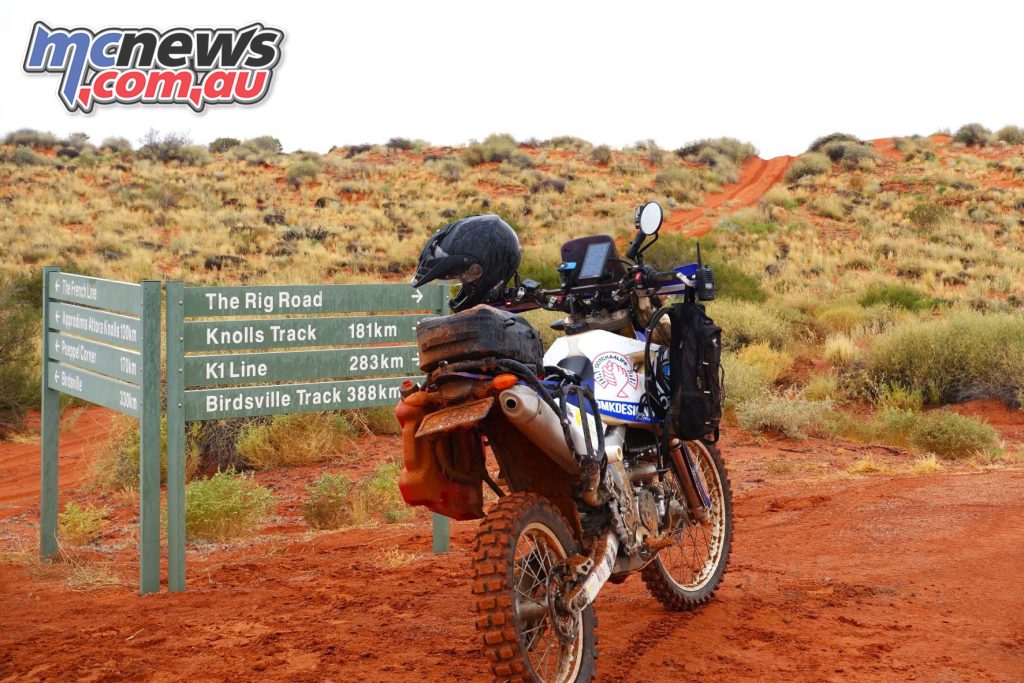
I’m filled with excitement as I see my first real sand dune and a sign welcoming me to the Simpson Desert. My confidence is short lived as the desert quickly knocks me down to size.
It’s with a sense an excitement and mild terror that I begin to accelerate the WR up the first series of sand dunes. I’m incredible thankful for the short training I’d done a month or so earlier, however it seems I’ve remembered none of it as I awkwardly crest the dunes, stop, then paddle down the other side. I’ll never make it to Birdsville if I try to walk the bike down every sand dune.
The 4WDs are now travelling behind me as I try to find my rhythm, however the task ahead quickly overwhelms me. As I crest about my fourth dune I make a rookie mistake and shut down the throttle, causing the front tyre to dig in and tossing me off the bike. Okay – I’ve lost my virginity and crashed in the sand, no big deal. I lift the bike, roll back down the dune and power back up the next dune.
Unfortunately I make the same mistake on the very next dune, however the landing wasn’t quite as forgiving. I still don’t know what happened, but I suspect I trapped my right foot either under the swing arm or the right pannier rack. My Gaerne motocross boots did their best, but a sharp pain through my heel and ankle suggested I was in for a long day.
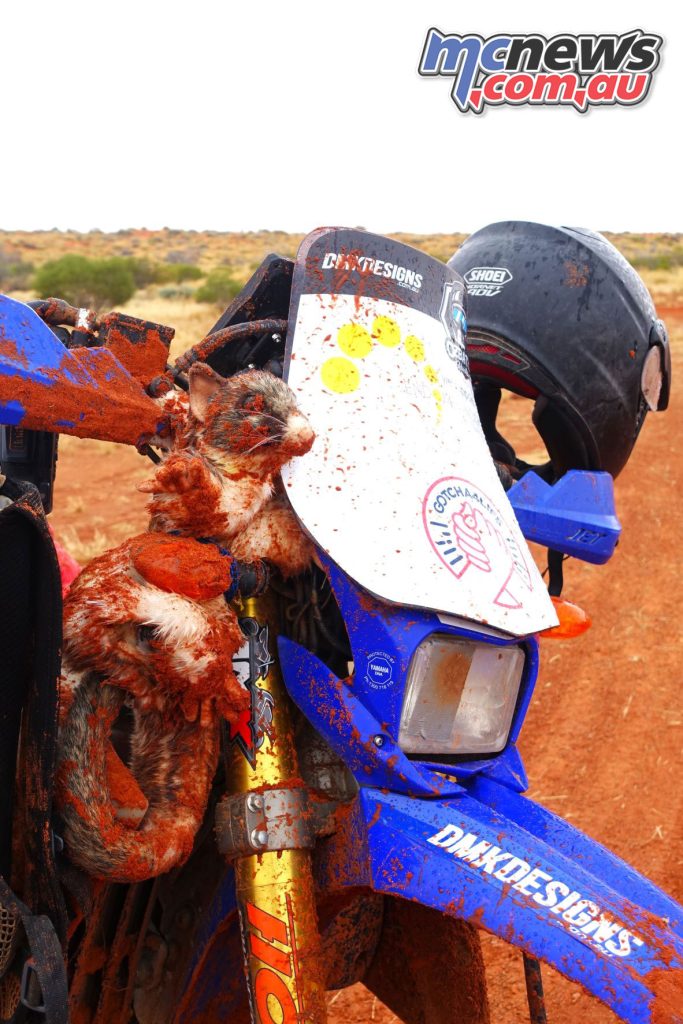
It’s too late to turn back now, however simply standing on the pegs is painful and if my math is correct I still have about 1,095 sand dunes to go. The next few hours were a series of powering up the dunes and paddling down the opposite side which were even steeper and badly rutted by 4WDs.
The pain in my ankle comes and goes depending on the level of adrenaline cursing through the veins. I’m completely out of my depth, simply focused on how I could crest the next dune and make it down the opposite side without crashing again.
145 km after leaving Dalhousie Springs we find a flat section between two dunes to make camp. I was completely exhausted, in pain and doubting my ability to finish the crossing. On a positive note, the rain has stopped.
The boys knew I was struggling, mainly because I was quiet. I’m not a quiet guy. Mick hopped onto the tailgate of the Ranger to remove my boot and assess the ankle. After some colourful language during my boot removal, a blue and purple heel is revealed.
My ankle is swollen and bruising is also appearing on my lower foot. Mick whips out his first aid kit and begins to tightly wrap my foot and ankle – to some more colourful language from myself.
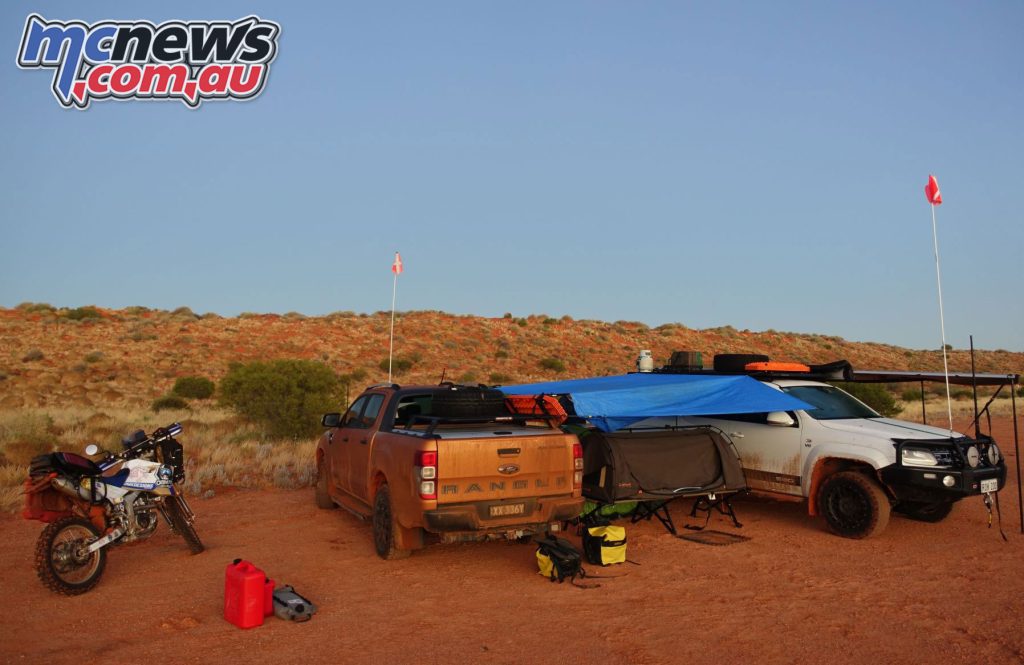
I can’t say I enjoyed my first night in the desert. I sat in my chair by the fire feeling sorry for myself, in pain and overwhelmed by the situation. For the first time I was genuinely concerned that I wouldn’t be able to complete the crossing, knowing it was only to get more difficult, meaning I couldn’t imagine how I could finish the trip successfully.
The guys kept my spirits up as we joked around the fire and I cracked open a bottle of 12 year old Bundy I’d received for my 51st birthday. If this was a solo crossing I’d probably have turned back.
I excuse myself from the campfire festivities early, and limp towards my tent. Its an exercise in yoga to attempt to climb into my tent with my ankle, but in stages and cursing I get there. It was a long night with little sleep and constant thoughts of doubt.
I’m woken by a sharp pain in my foot, not from the sprain, but my foot had swollen overnight and the bandaging was cutting into my foot. I quickly unwrap it, the pain subsides offering some confidence that my ankle has miraculously recovered.
Alas the first attempted step from the tent shatters that thought, and I hop towards the fire which the boys have already started for breakfast. They ask how I’m feeling, and of course I lie and declare I’m excited for the day ahead.
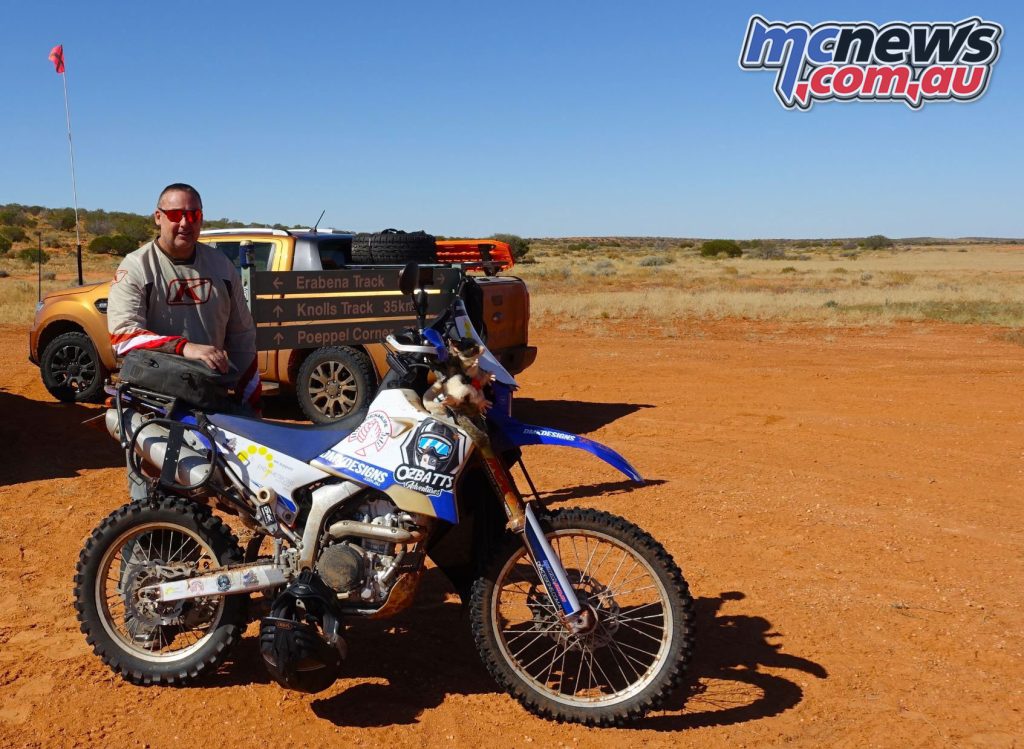
The night of poor sleep wasn’t all bad, it allowed me to relax, calm down and think through what went wrong. “In sand momentum is you friend” – these words kept ringing in my ears and looking back this is what I’d failed to do.
I announce to myself that today is new day, and I’ll approach it with newfound knowledge and confidence. Power up the dunes and ride down the backside regardless of how steep and rutted they are.
We pack up camp and prepare for departure heading into what will be the most difficult day of the crossing and the hardest days riding in my life. Camping between dunes means there is no opportunity to warm up, you hit the sand track, turn left and accelerate up the next dune.
I increase my speed for the approach, holding third gear, before shifting down to second as I approach the crest. Many of the dunes have a sharp right turn at the crest, but I convince myself to carry momentum in the loose sand as I begin the descent. The throttle quickly becomes my friend as I accelerate and keep the front wheel light over the deep ruts.
In a weird twist of fate my sprained ankle has become the turning point in my sand riding. Due to the pain and weakness in my ankle I am unable to paddle down sand dunes, forcing me to stand on the pegs and embrace momentum.
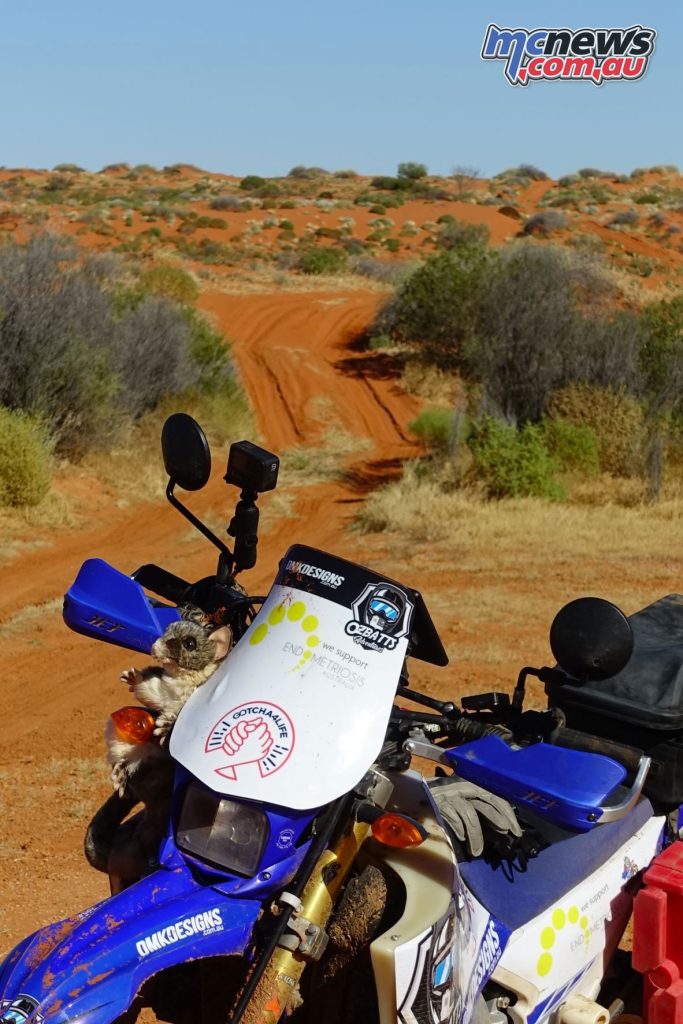
This combined with the advice from riding buddies ringing in my ears (thanks Chris, Trent and Mick) I’m actually looking forward to attacking the approaching dunes.
The aim for the day is continuing on the French Line towards Peoppels Corner; where South Australia, Northern Territory and Queensland meet. Distance means nothing in the desert, instead you measure your day by hours of riding while managing dehydration and fatigue. Poeppels is only 140 km away, yet I’m about to learn it’s a full day’s ride and one I will never forget.
Prior to leaving Adelaide I heard, and even threw around numbers with little understanding of what they actually mean. ‘500 km across the desert and 1100 sand dunes.’ Just take a moment to think about that, one thousand and one hundred sand dunes.
The sand riding and dunes simply did not end, it was a continual ritual of cresting a twisting dune, accelerating down the back side and preparing for the next climb. The small gaps between the dunes were soft, rutted and contained hidden perils which caught me out if I attempted to rest my thighs and sit.
Descending one dune I excitedly observe a hard packed clearing, this was an opportunity to stop the bike, take a sip of water and catch my breath. Reviewing my GoPro footage I look – and sound – exhausted, breathing heavy and wincing in pain. At this point I felt like I have been on the bike for an hour or so, but alas it was barely 20 minutes and I was exhausted.
For the next hour I manage to settle into a better rhythm, I’m still struggling, but in some uncanny way I start to embrace and enjoy the challenge. This section now incorporates long sections of ruts, dips and sand washout strategically placed between dunes to ensure you have no opportunity to rest.
For a novice sand rider like myself there is no break in concentration, and the few times I dare to sit the sand comes up and bites me with a strong warning of, ‘Get your ass off the seat.’
I know this sounds crazy, but I am even struggling to grab my hydration pack tube to drink for fear of letting go of the bars. Dune by dune my confidence grows however and the excitement of the ride has me ignoring my ankle as my boot does a great job of providing support.
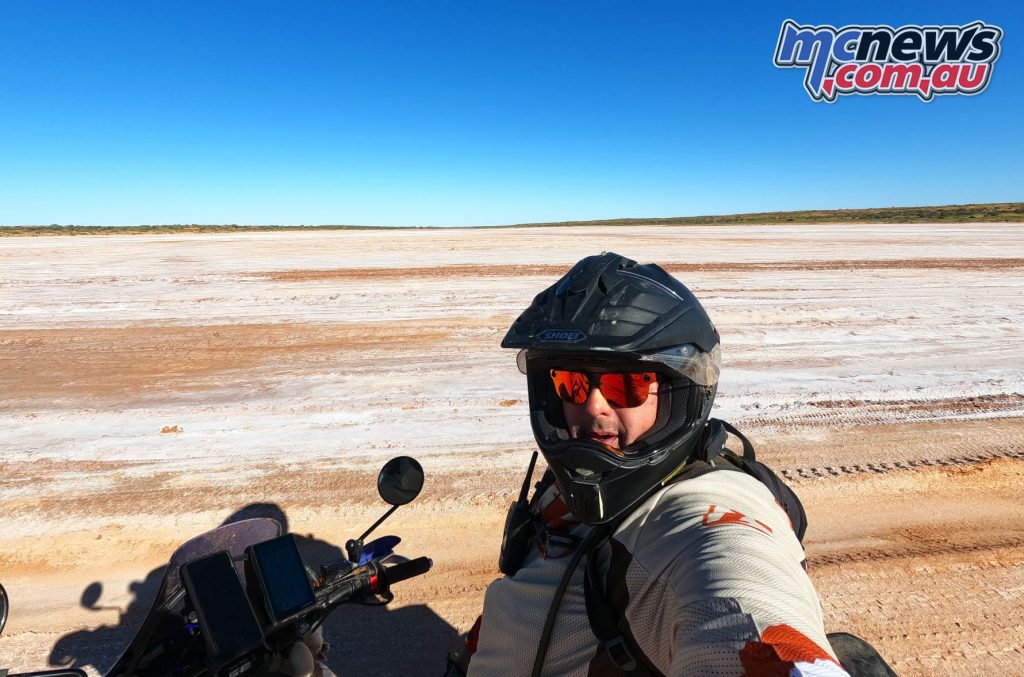
Speaking of support, only twelve months ago I had never heard of Steg Pegz or similar items such as skateboard wheels which provide support to your calf while standing. My WR had a home made set fitted by the previous owner and I cannot speak highly enough of how effective they are. I found I was able to stand for longer and it removed the pressure and weight from my shoulders and forearms – for me they worked.
Suddenly cresting a taller dune a sight appears which brings an instant smile to my face – a wide open salt/clay pan. A sight that terrified me in the wet is a welcomed site as it means sitting on the seat for a few minutes and a chance to stop and take a few photos.
These wide open pans become more regular as the day progresses and all have signs of deep tyre tracks where 4WDs have become immobilised and buried to their axles. It’s tempting to detour from the track and play on these pans however the idea of getting bogged for hours trying to retrieve the WR has common sense prevail.
My mindset has completely changed as I find myself immersed in the challenge of crossing the Simpson. I wouldn’t be as dramatic as suggesting I was in survival mode, but I was enjoying the challenge and for the first time beginning to believe I would conquer my fears and complete the crossing.
The riding was more difficult and technical, yet I felt more confident and comfortable. Proof that riding sand is a mental challenge and about overcoming your fears.
I highly recommend the use of a handheld UHF radio too if you are entering the desert. This enabled me to keep in contact with the 4WDs, but more importantly I could hear transmissions of oncoming vehicles and be cautious when cresting dunes.
A large pan appears and I decide it’s a great opportunity to stop, wait for the 4WDs, check over the bike and consider our lunch options. After a few photos and change of mounting positions for my GoPro, the boys appear over a dune and meet me in the middle of the pan. I clearly have no concept of time and suggest it would be great time for lunch. Mick looks at me quizzically and states, “Batts its nearly four o’clock.”
I’d been so focussed and in a zone that seven hours had passed since we broke camp and we are only a few kilometres away from Poeppel Corner.
I’m not sure what happened next, but suspect it was simply that we had stopped and the adrenaline had ceased flowing. I was hit with a wave of fatigue, exhaustion and pain in my ankle, making it difficult to focus. I knew it was mental, and realised I had to dig deep to make it through the day.
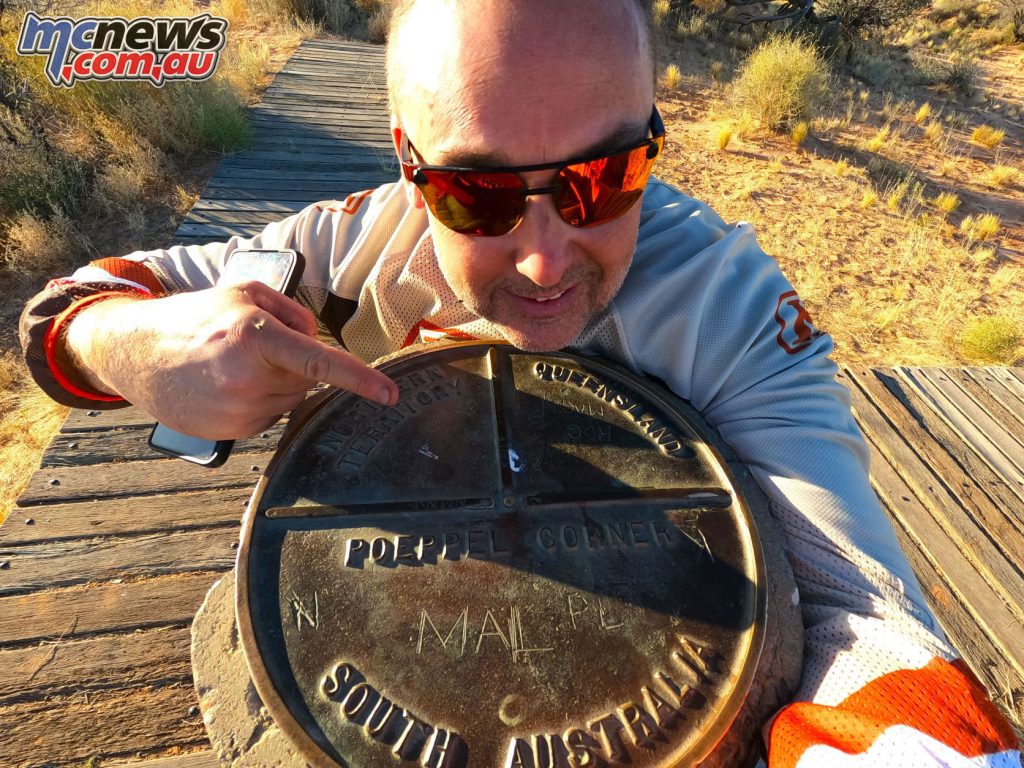
In no time we are approaching Poeppel Corner and meet up with another traveller who is heading west towards Mt Dare. I ask about the track conditions, and he can clearly see I’m struggling at the end of the day, “You’ll love it, there’s a flat easy section that runs along the pan for about twenty kilometres.” Music to my ears.
We take the boardwalk out to the corner marker and I do the usually tourist commentary of circling the post announcing each state proudly as I step into them. My walk now more resembles a hobble as I make my way back along to boardwalk towards the WR. I let the boys know I’m keen to find a campsite soon – as I’ve reached the end of energy levels for the day.

Upon leaving Poeppel we soon head north along the massive salt/clay pan along the K1 Line to the QAA Line. As we head north our eyes eagerly search to our left for signs of tracks leading to a potential campsite. We travel for what seems an hour or so, but in reality was probably only fifteen minutes searching for the perfect spot.
The 4WDs are ahead and I see them slow to look at options. I decide the stop the WR for a quick break and hit the kill switch. After a short break, I hit the starter to fire the girl to life and nothing. Suddenly the realisation of being in the middle of the Simpson Desert, over 100 kilometres from Birdsville hits me.
I reset the kills switch, turn the ignition off and on and hit the starter button again… she fires straight to life. A huge sigh of relief and I catch up with the boys in search of our night’s accommodation.
Suddenly the UHF emits a loud “Ooh yeah” as Norri discovers the perfect soft sandy site with another existing fire pit. We had joked with Norri upon departure as he brought his own firewood, but no one was laughing tonight as we set up camp and enjoyed the glow of the fire. The evening sunset was spectacular as it cast a glow over the expansive clay pans.

In all my motorcycle travels which have included West to East on a Harley in the USA, attending the iconic Sturgis, and touring Australia, nothing compares to sitting around a campfire after a day of exploring.
An added bonus is that Norri had found a Bundy can which had somehow worked it’s way to the bottom of his fridge and was hiding under a packet of steak. That had to be the best tasting can of alcohol in my life.
I have to share one of most unusual sights I experienced in the desert, and one that would terrify my American friends. It was late at night and I need to walk away from the fire to visit a local tree. Cloud cover meant the night is dark and I rely on my headband light to guide the way.
A few feet in the distance I see a tiny reflection in the sand illuminated by my headlight. Initially I think it’s a tiny piece of reflective material or perhaps a metallic object dropped by a tourist. As I bend down to pick it up I see it’s a small spider, the headlight torch actually reflects off their eyes – am I the only one that just learnt this?
I call out to the guys to come and take a look, and as my headlight swings around I realise there are dozens of tiny spider’s eyes looking at me and I’m completely surrounded. I have visions of Indiana Jones grabbing a large stick, dowsing it with fuel and waving it at these arachnids to clear a safe path to my tent. I will admit I immediately double check the fly was zipped tightly on my tent.
As I lay in my tent that evening two thoughts dominated my mind. One – that was the most challenging days ride of my life. Two – I felt better than I did on day one in the desert and now firmly believed I can make it to Birdsville.
Stay tuned for Part 4!
You can check out the full Long Way to Wauchope Rally series here (link).
Also check out Endometriosis Australia and Gotcha4Life if you’re interested.























